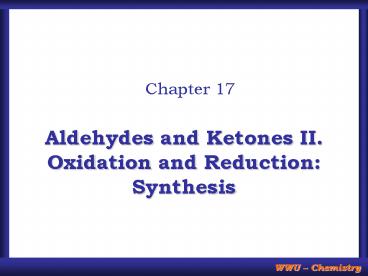Aldehydes and Ketones II. Oxidation and Reduction: Synthesis - PowerPoint PPT Presentation
1 / 34
Title:
Aldehydes and Ketones II. Oxidation and Reduction: Synthesis
Description:
Chapter 17 Aldehydes and Ketones II. Oxidation and Reduction: Synthesis Assignment for Chapter 17 Sections 17.0 through 17.2 Section 17.3 -- SKIP Sections 17.4 ... – PowerPoint PPT presentation
Number of Views:396
Avg rating:3.0/5.0
Title: Aldehydes and Ketones II. Oxidation and Reduction: Synthesis
1
Aldehydes and Ketones II. Oxidation and
Reduction Synthesis
- Chapter 17
2
Assignment for Chapter 17
- Sections 17.0 through 17.2
- Section 17.3 -- SKIP
- Sections 17.4 through 17.12
- Section 17.13 through 17.15 -- SKIP
- Sections 17.16 through 17.20
- Problems
3
Problem Assignment
- In-Text Problems
- 17-1 through 17-11
- 17-15 through 17-18
- End-of-Chapter Problems
- 1 through 4 (all parts)
4
Reduction of a Carbonyl Group to an Alcohol
5
What If We Had the Worlds Simplest Nucleophile?
6
- If we could make this work, we would have means
of reducing the carbonyl group. - Go back and re-read the Special Topics box at the
beginning of Chapter 14.
7
Lithium Aluminum Hydride
Lithium aluminum hydride, LiAlH4, is a very
powerful hydride donor, and thus it is an
excellent reducing agent.
8
Outline
9
Lithium Aluminum HydrideReduction of
Aldehydesand Ketones
These reactions typically go in very high yield.
10
Learn it this way
11
Aluminum is required to coordinate with the
oxygen of the carbonyl group. For example, in the
absence of aluminum (using sodium hydride, NaH as
the reducing agent), there is no reduction.
12
You Must Be Careful!
LiOH Al(OH)
4 H2
LiAlH
4 H
O
4
2
3
13
A similar, but less reactive, reducing agent is
sodium borohydride, NaBH4.
14
Sodium Borohydride Reduction of Aldehydes and
Ketones
15
Example
In general, the reduction should proceed equally
easily from either side, yielding two
mirror-image products.
16
Sodium Borohydride Reduction of Camphor
(endo)
(exo)
In this case, approach by borohydride from the
upper side is sterically hindered by the bridge
methyl group. The result is a predominance of
exo alcohol.
17
Sodium Borohydride Reduction of Norcamphor
- Here, it is the underside of the molecule that is
more sterically hindered, so the favored alcohol
is the endo alcohol. - Similar results are obtained with lithium
aluminum hydride.
18
Another example
19
Contrast these two reactions
Note that sodium borohydride is more selective.
20
Catalytic Hydrogenation ofAldehydes and Ketones
21
Reduction of a Carbonyl Group to a Methylene Group
22
We are trying to accomplish...
23
Clemmensen Reduction
Zn(Hg) is a zinc amalgam
24
- The mechanism of the Clemmensen reduction
involves the formation of some sort of
zinc-ketone complex. - This reaction is a good method for the reduction
of acid-stable carbonyl compounds (Note that the
reaction takes place in the presence of
concentrated HCl).
25
Example of a Clemmensen Reduction
Notice that the reduction does not affect the
carboxyl group
26
Wolff-Kishner Reduction
27
- The mechanism involves the formation of a
hydrazine adduct, which loses water to form a
hydrazone. - The hydrazone then rearranges to lose a molecule
of nitrogen gas, leaving behind a carbanion. - The carbanion picks up a proton from the solvent
to form the product.
28
This will never show up on any of my exams!
29
The Wolff-Kishner reduction is useful for the
reduction of carbonyl compounds that are stable
in strong base. (Note that the reaction takes
place in the presence of concentrated KOH or
other base)
30
Example
31
Desulfurization
32
- Advantages High yields
Mild and nearly neutral
reaction conditions - Disadvantages Stinky!
Raney Nickel is tricky to prepare
33
Example of a Raney Nickel Desulfurization
34
(No Transcript)

